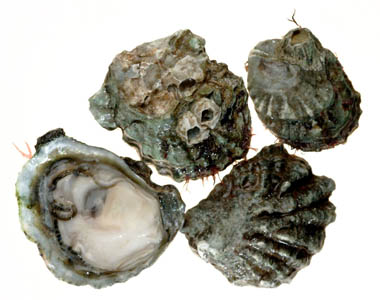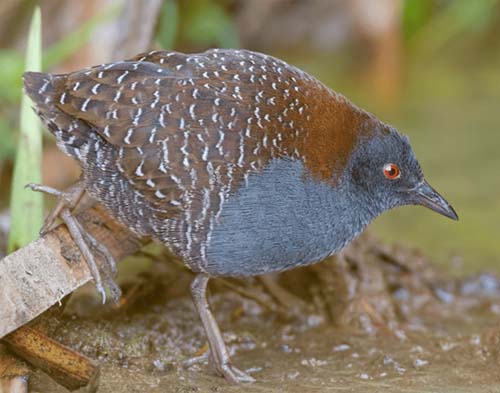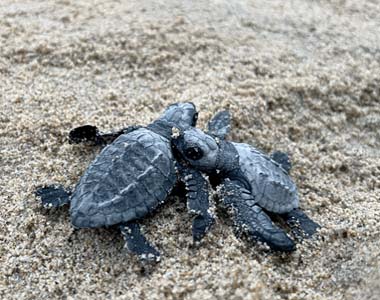 | | | The first month of the new year has already seen conservation successes and severe risks to oceans and marine life. This January issue of the RCC Coasts and Oceans Observer explores a community’s efforts to protect vulnerable sea turtles, the extinction of a fish species, developments in offshore wind and ocean trawling, and more.   Some progress first. In Texas, the Galveston Bay Foundation has purchased 63 acres of coastal wetlands with funds from the U.S. Fish and Wildlife Service. The acquisition will prevent development of critical habitat for wildlife, including the Eastern Black Rail, a bird species listed as threatened under the Endangered Species Act. On the Pacific Coast of the U.S., scientists are raising awareness for the Olympia oyster, which has recently made a recovery in its native habitat. These oysters play an important role in water filtration that benefits the entire coastal ecosystem. Some progress first. In Texas, the Galveston Bay Foundation has purchased 63 acres of coastal wetlands with funds from the U.S. Fish and Wildlife Service. The acquisition will prevent development of critical habitat for wildlife, including the Eastern Black Rail, a bird species listed as threatened under the Endangered Species Act. On the Pacific Coast of the U.S., scientists are raising awareness for the Olympia oyster, which has recently made a recovery in its native habitat. These oysters play an important role in water filtration that benefits the entire coastal ecosystem. Meanwhile, in Massachusetts, Vineyard Wind, the second large-scale offshore wind farm in the U.S., began generating power this month. Renewable energy will become more important as emissions from extractive industries rise. A recent study found that ocean trawling (a method of fishing that disturbs the sea floor) can release up to 370 million metric tons of carbon dioxide. The coastal U.S., where about 29% of the population resides, faces high risks from severe storms and sea level rise. In response to more extreme weather, the Massachusetts Department of Environmental Protection has recently announced plans to limit development in the coastal floodplain with the goal of preventing damage during storms.  But human-induced threats remain. On the west coast of Mexico, scientists and community members are working to protect olive ridleys, a species of sea turtle, from poachers and other threats. The initiative, called “Project Tortuga,” has become increasingly important as the beach faces further tourism and development. But human-induced threats remain. On the west coast of Mexico, scientists and community members are working to protect olive ridleys, a species of sea turtle, from poachers and other threats. The initiative, called “Project Tortuga,” has become increasingly important as the beach faces further tourism and development.
Human activity in the ocean has had devastating effects on marine ecosystems, including a recent species extinction. The Java stingaree, a close relative of the stingray from the Java sea in South East Asia, is the first fish extinction caused by humans.
Nevertheless, amid these human-caused threats to marine life, technological advancements have made it easier to monitor activity on the ocean. Artificial intelligence now allows researchers to track previously undetectable fishing vessels to better understand fisheries exploitation. The impacts of human activity and climate change on marine systems reach all corners of the globe, even affecting people who have never set foot in the ocean. That has led me to explore how the ocean and inland communities deeply influence one another in my essay, “Rachel Carson, the Ocean and Our Future.” This year will undoubtedly be filled with climate change, conservation, and policy challenges, but even more opportunities for progress. We cannot relent from working toward a brighter future for coasts and oceans. And it will take all of us. | | | | | | | |  Emma Brentjens - RCC National Environment Leadership Fellow (Presidential) Emma Brentjens - RCC National Environment Leadership Fellow (Presidential)
Emma Brentjens is the co-lead of the RCC Coasts and Oceans program. She is a Master of Environmental Management student at Duke University studying Ecosystem Science and Conservation and Community-based Environmental Management. | | | | | | How Crowded Are the Oceans? New Maps Show What Flew Under the Radar Until Now Advances in AI and satellite imagery allowed researchers to create the clearest picture yet of human activity at sea, revealing clandestine fishing activity and a boom in offshore energy development. Using satellite imagery and AI, researchers have mapped human activity at sea with more precision than ever before. The effort exposed a huge amount of industrial activity that previously flew under the radar, from suspicious fishing operations to an explosion of offshore energy development. | | | | | | | | Rachel Carson, the Ocean and Our Future I still remember the feeling of cool sand beneath my feet and the sound of rolling ocean waves from beach trips when I was a kid. My family and I visited the Outer Banks of North Carolina every October. The scent of the ocean always hit me before I reached the shore, carried on an autumn breeze. With each breath, I inhaled the salty sea spray, and the ocean and I grew closer, inseparable. What I didn’t realize at the time was that each breath of salty air came not only from, but because of the ocean. | | | | | | | | An Amazing 200 Million Year-Old Race S. and I sit on a log on a San Pancho beach of western Mexico’s Nayarit coast, watching. Soon, we’ve been told, there will be a release of sea turtles, but we don’t know quite where, so we observe the movement of humans on the beach—couples in beach chairs; groups of young, tattooed surfers smoking cigarettes and weed; a woman reading a book. An older man races by in a dune buggy with a woman beside him, and then returns a moment later without her, rousing a trio of short-legged mutts to chase after him, barking and chomping at the tires. | | | | | | | | First Marine Fish Declared Extinct Due to Human Activity A species of ray, so rare it has only ever been recorded once back in the late 1800s, has been declared extinct after an assessment by an international team led by Charles Darwin University (CDU). In 1862, Eduard von Martens, a German naturalist who was part of a multi-year expedition, bought a small dead stingray from a fish market in Jakarta, Indonesia. He named the species the Java stingaree or Urolophus javanicus. The species was only known from that specimen collected and has not been recorded. | | | | | | | | How to Love an Oyster Most people, even those who know a thing or two about oysters and may perhaps enjoy eating them, have no idea that the sweet and buttery bivalves they are slurping down in San Francisco or Vancouver are not the native species of the West Coast but Japanese imports. It’s an easy mistake to make, considering that Japanese oysters (Crassostrea gigas) are commonly referred to as Pacific oysters—as in western Pacific—though they have been commercially cultivated in North American waters for nearly a century. | | | | | | | | Galveston Nonprofit Acquires 63 Acres to Protect Some Threatened Island Habitats The acquisition will protect other important geographic features to Redfish Cove that serve its native wildlife like coastal wetlands, prairie and upland buffers, according to the foundation. In an effort to protect some of the coast’s most vulnerable habitats, Galveston Bay Foundation acquired 63 acres of land along Galveston Bay in an area commonly referred to as Redfish Cove, the organization announced last week. | | | | | | | | No More Beachfront Homes? New State Regs Could Limit Coastal Development The state is looking to limit new homes from being built along the most vulnerable areas of the coast as part of an effort to better prepare for climate change. For years, the Massachusetts Department of Environmental Protection (MassDEP) has been working on a suite of new rules and changes to the Wetlands Protection Act and waterways regulations. Officials are calling the newly announced plans “Resilience 1.0” and said they will soon release more plans to help communities prepare for extreme weather. | | | | | | | | Living Shorelines Gain Ground Around the Chesapeake Bay But Face Hurdles When a 2-foot chunk of shoreline washed away from their waterfront property in Portsmouth, VA, the Berners decided it was time to prevent further erosion at their home of 15 years. At the behest of their college student son, Christian, they turned to the Chesapeake Bay Foundation and Elizabeth River Project for help. Last summer, squads of volunteers showed up to build a 718-foot “living shoreline,” spreading 400 tons of sand, placing 2,400 concrete oyster “castles” and planting 2,500 plugs of marsh grasses. | | | | | | | | Where War Looks Lost, Mother Nature Fights Climate Change Point Peter Road leads straight into the Croatan Sound where rising seas, higher tides, and monstrous storms batter the fragile coastline. The saltwater poisons and erodes the peaty soil before what’s left disappears under the relentless waves. A man-made canal carries the seawater inland where it kills cypresses and pines and turns the forest into shrubby marsh. Freshwater, blocked from running into the bay by the rising sound, pools under trees and kills them. | | | | | | | | Massachusetts Switches On Its First Large Offshore Wind Farm Vineyard Wind is the country’s second large-scale offshore project to start producing electricity and comes at a turbulent time for the industry. The first large offshore wind farm in New England has started producing electricity, a milestone for an industry that has struggled to get off the ground over the past year. The power started flowing late on Tuesday. For now, the Vineyard Wind project, located off the coast of Martha’s Vineyard, Mass., can send only five megawatts of power to the grid from a single towering wind turbine. | | | | | | | | | | Iconic Maine Fish Shacks Completely Destroyed During Storm We are seeing videos of damage coming in from across Maine after waves battered the state's coastline. In Willard Beach, the iconic fish shacks were pulled apart and floated into the ocean. All three shacks have been completely destroyed, according to officials with the city of South Portland. Work has been done over the last few years to preserve part of Maine's fishing history. | | | | | | | | Ocean Trawling May Release Locked-Away Carbon Some scientists say the controversial fishing practice of ocean trawling stirs up buried organic matter, some of which makes its way to the surface in the form of carbon dioxide Dragging giant nets along the seafloor to catch fish — a practice known as bottom trawling — has long been criticized by environmentalists as destructive to underwater ecosystems. Now, research suggests it’s bad for the climate as well. | | | | | | | | Florida Teen Transforms Trash Into Art For Ocean Conservation A Florida teen is turning the tide on ocean pollution by transforming beach trash into captivating art pieces. Ryan Moralevitz’s dedication to cleaning up waterways has garnered attention, leading to a significant showcase on Carnival Cruise Line in Port Tampa Bay. Initiated under the banner of “The Fishes Wishes,” his organization began with a simple donation and has evolved into a powerful force for ocean conservation. | | | | | | | |  The Rachel Carson Council Depends on Tax-deductible Gifts From Concerned Individuals Like You. Please Help If You Can. The Rachel Carson Council Depends on Tax-deductible Gifts From Concerned Individuals Like You. Please Help If You Can. | | | | | | | |  Sign Up Here to Receive the RCC E-News and Other RCC Newsletters, Information and Alerts. Sign Up Here to Receive the RCC E-News and Other RCC Newsletters, Information and Alerts. | | | | | | | | | | | |